Ars Electronica is making its second guest appearance at Science Centre Singapore. The successful debut was a large-scale exhibition in 2007. Now, eight years later, the follow-up entitled “INTERPLAY – Ars Electronica Linz Meets Science Centre Singapore” is more modest in scope, but this compact package delivers awesome content once again.
Type: Exhibition
Duration: May 29 to August 16, 2015
City, Country: Singapore
Venue: Science Centre Singapore
A mobile version of Deep Space, the multidimensional projection & experience domain that’s a favorite of visitors to the Ars Electronica Center, and seven other art projects will definitely dazzle Science Centre audiences with breathtaking images of the micro- and macrocosm. Attendance of 55,000+ is expected during INTERPLAY’s run from May 29 to August 16, 2015.

Art is in play, and this exhibition sheds light above all on playful encounters in art. Play can give rise to something new—the Futurists, the Dadaists, Fluxus artists and the Situationists were convinced of this: “only play can deconsecrate, open up possibilities of total freedom. This is the principle of diversion, the freedom to change the sense of everything which serves Power” [1].
Play calls power structures into question. Chance also plays a major role in play. The outcome of a game normally cannot be predicted, planned or programmed. Play as a process demands the player’s full attention. In Homo Ludens (1938), Dutch cultural historian Johan Huizinga put forth a very early explanatory model whereby human beings develop their capabilities above all by playing.
When children at play are “only pretending” or doing something “only for fun,” the prevailing system is, according to Huizinga, not a matter of “‘ordinary’ or ‘real’ life. It is rather a stepping out of ‘real’ life into a temporary sphere of activity with a disposition all of its own.”[2] The fact that both play and art can entail an abstraction of reality is alluded to by the title INTERPLAY and demonstrated by the artistic works presented in it.
[1] Daphne Dragona, Who Dares to De-Sacralise Today’s Play? in: Centro de Arte y Creación Industrial, Homo Ludens Ludens. Third Part of the Gaming Trilogy, Gijon 2008, p. 42
[2] Johan Huizinga, Homo Ludens, London, Boston and Henley 1980, p. 8
An Ars Electronica Academy will be held on the exhibition’s opening weekend. During this two-day conclave, attendees will join the participating artists in scrutinizing and questioning playful approaches in artistic practice today.
Artworks
Jun Fujiki (JP), 2012
Game Border
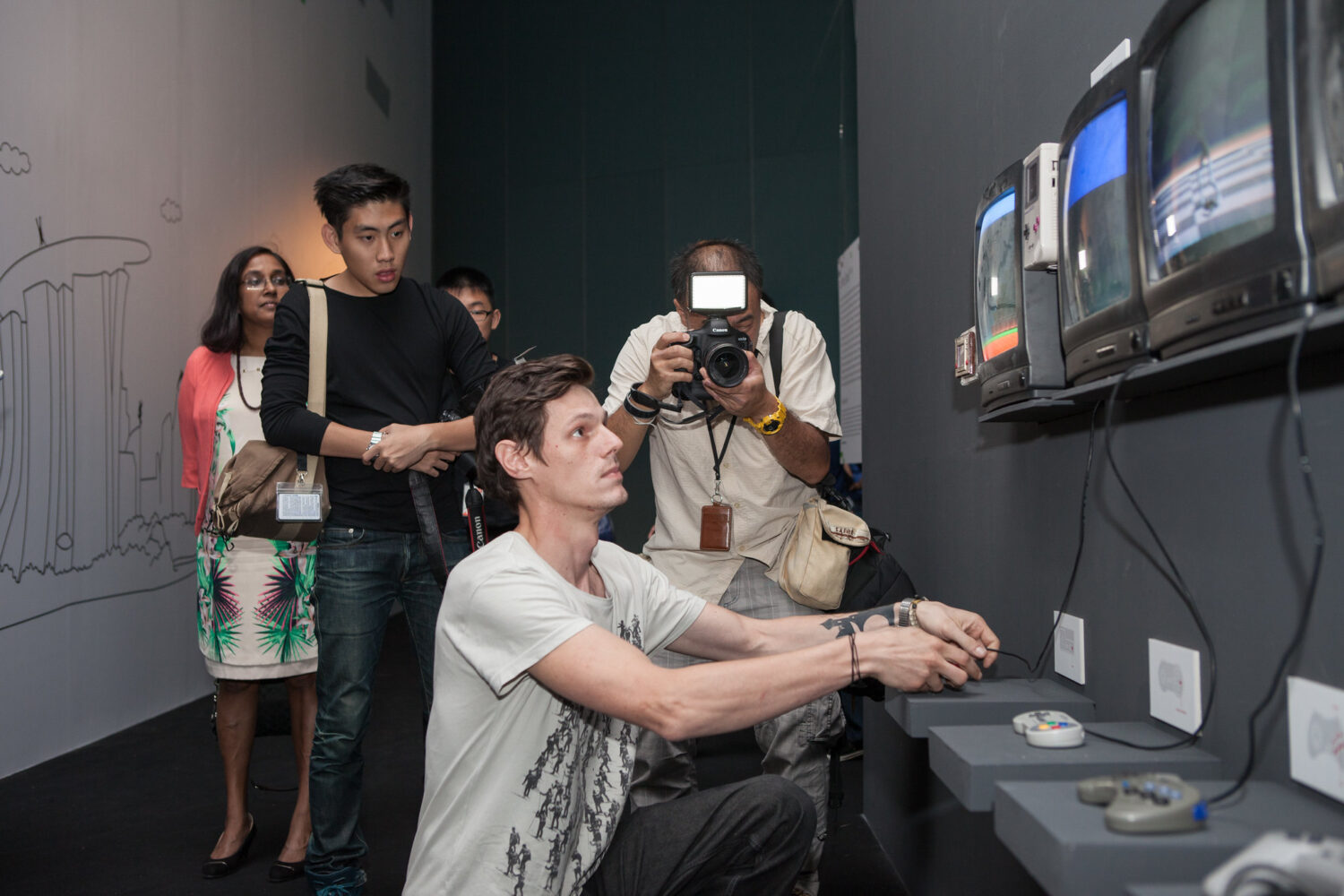
This is a game that one can enjoy with the feeling of jumping from one game machine to another, transcending the borders of hardware. In addition, this is a challenge to connect the borders of various games seamlessly. The borders here are not limited to the physical, but include the borders of recognition and society.
Marek Straszak (DE/PL), 2013/2015
ArsRecollected

ArsRecollected is an installation inspired by facts from Ars Electronica in Linz, Austria as well as its activities internationally. The idea of technology while meeting art and design is covered by five parts of the installation: the Ars Electronica Center, the Ars Electronica Festival, the Prix Ars Electronica, the Ars Electronica Futurelab and Ars Electronica Solutions. Each of these topics is described in the form of infographics, illustrations, video-animations and simply kinetic systems. Each storyline goes chronological from 1979 up to now, in which one year is represented by a 3 seconds of installation-life in a loop. ArsRecollected is based on the former project XXrecollected by Marek Straszak. It is about the language of new media that is brought onto one wall and that mixes the “real” with the digital and creates a multi-layered experience. Great inspiration for this work was derived from Rube Goldberg and the Mécaniques Discursive installation.
Nova Jiang (CN), 2011
Ideogenetic Machine
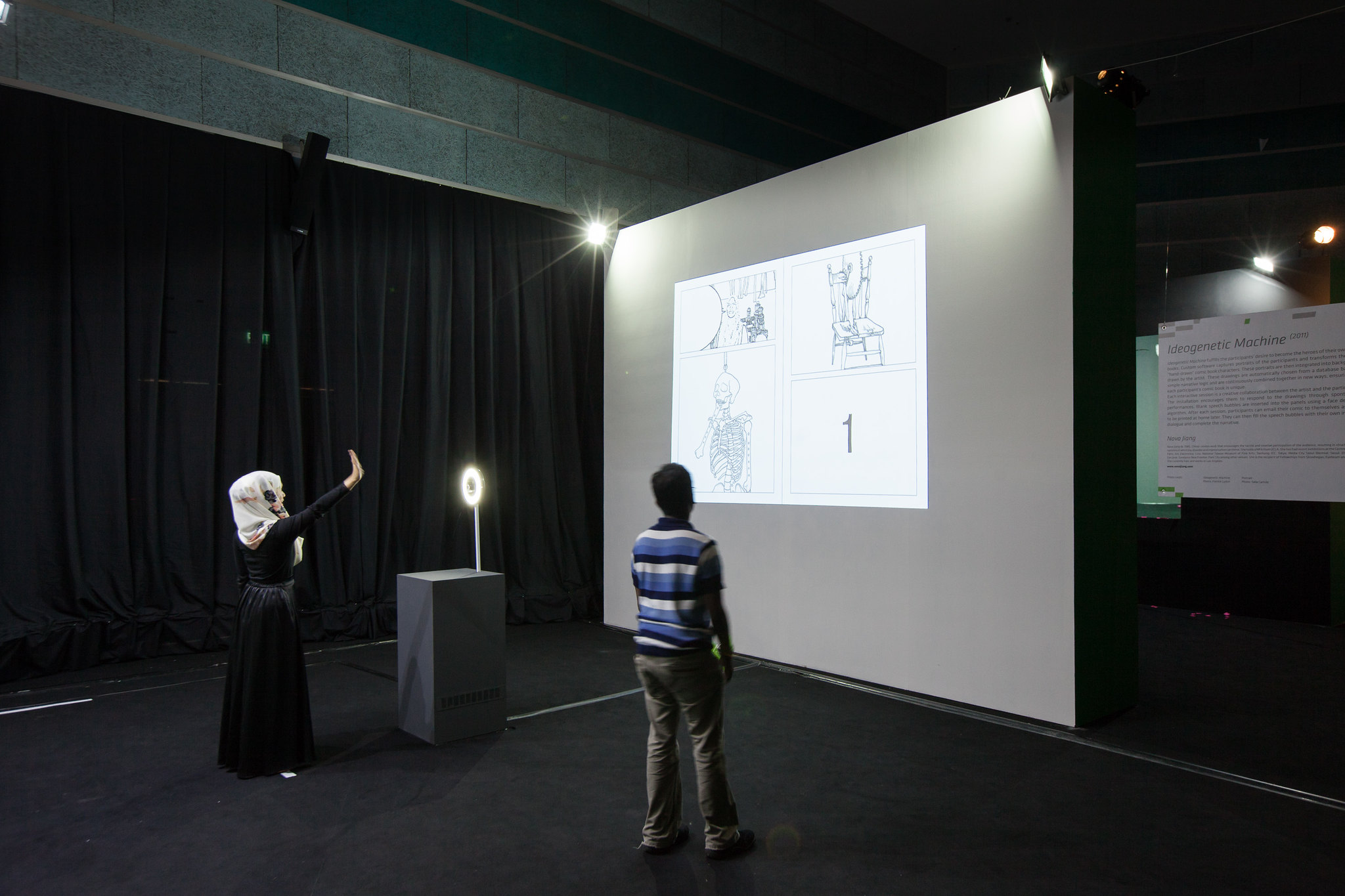
Ideogenetic Machine fulfils the participants’ desire to become the heroes of their own comic books. Custom software captures portraits of the participants and transforms them into “hand-drawn” comic book characters. These portraits are then integrated into backgrounds drawn by the artist. These drawings are automatically chosen from a database based on simple narrative logic and are continuously combined together in new ways, ensuring that each participant’s comic book is unique. Each interactive session is a creative collaboration between the artist and the participants. The installation encourages them to respond to the drawings through spontaneous performances. Blank speech bubbles are inserted into the panels using a face detection algorithm. After each session, participants can email their comic to themselves as a PDF to be printed at home later. They can then fill the speech bubbles with their own invented dialogue and complete the narrative.
Raquel Kogan (BR), 2012
o.lhar (look)

o.lhar is an interactive audio video installation that constructs a story in real time. It is a visual report of all the interactors passing through and interacting with the installation, which is incremented and modified through this process. In this audio-video installation, the interaction is simply a look that becomes something to be seen. The expectation of a look and then seeing something is its dialogue. The interactor looks into small built-in devices at various heights in the exposition space, inviting the spectator to take a peek, but he sees absolutely nothing. This look is captured in a sequence of photos and is projected in the form of short videos, one next to the other, forming the content of the installation, which is constantly being modified to adapt the new data captured (the look is first shown in a large projection to be easily recognizable; it then goes back to the order in which it occurred and returns to the smaller format). Inside the image-capturing device there is a digital interface connected to a computer that manages this enormous data bank created in real time and the number of the look is spoken aloud, placing the visitor in the order of his arrival. A visual sound diary of the people who were there and interacted with the installation.
Tine Papendick (DE), 2008
Digital Puppetry
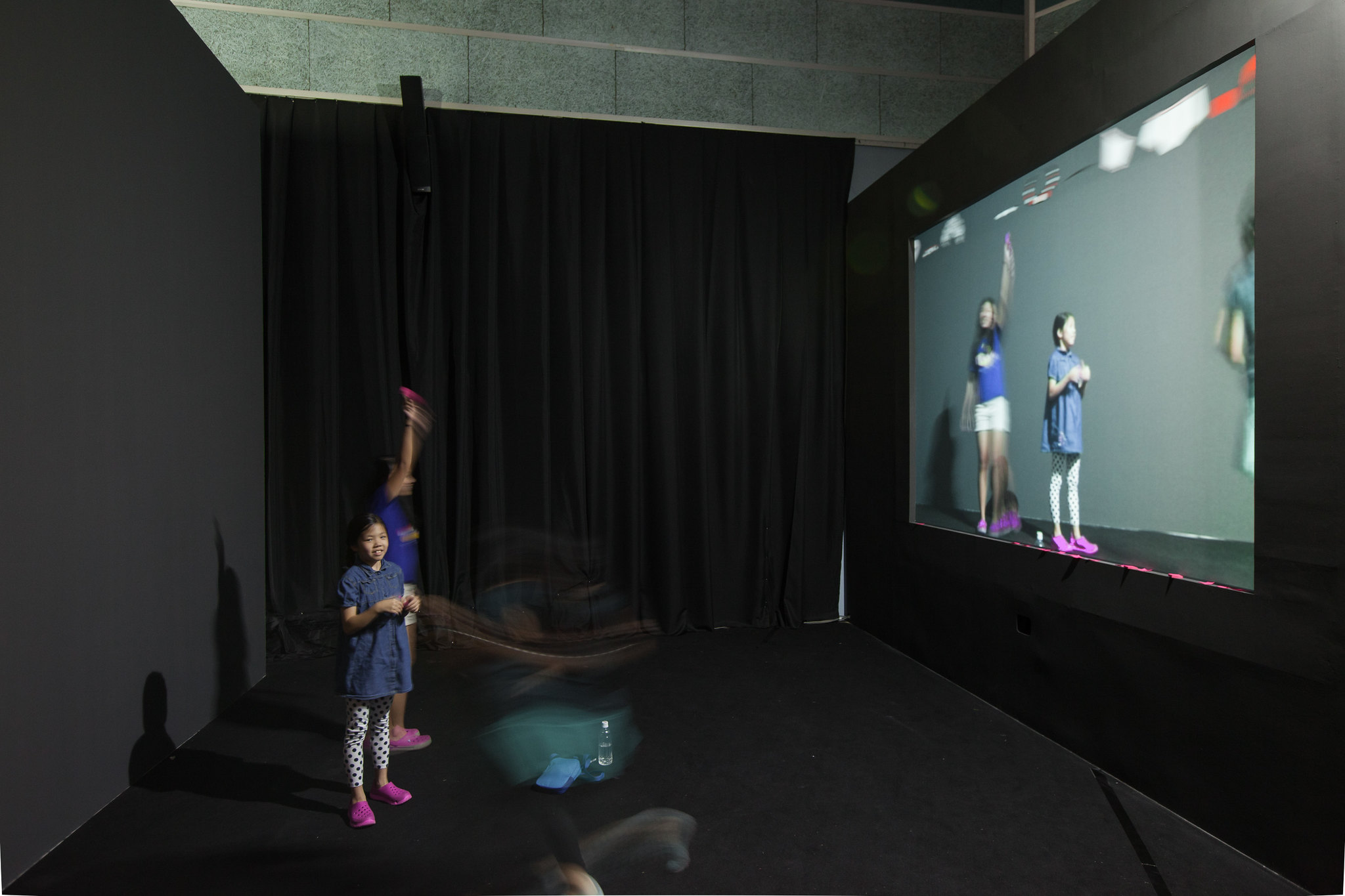
Did you ever want to be a comic hero, a gangster, someone totally different? Digital Puppetry is an interactive installation that allows you to alter your identity in a very playful way. Standing in front of a screen, you are looking at yourself like in a mirror. With the help of pink sticky notes, you can grab various items on the screen and attach them to yourself like a dress-up puppet. The original version of the installation was developed during the “interactivos workshop” at eyebeam center for arts and technology in New York. It has been successfully exhibited at international festivals and events. Furthermore, the concept/technology has been sold to various companies – including their corporate/commercial imagery.
Softstories (Isobel Knowles and Cat Rabbit), 2013
A Matter of Factory

Humans like to bend the universe to their will. Curiosity leads to experimentation, invention and eventually enterprise. As the dominant species, humans can create new life forms, shape and design specialised pets, guide ‘natural selection’ in farm animals. Humans are constantly breeding in the profitable traits (or defects) without too much thought for the repercussions. Humans are also currently interested in local and handmade products. In this climate, the successful micro-business may thrive and reach a point where they need to choose whether to embrace the success and expand to meet demand or whether they remain simply self-sustaining without economic growth. To industrialise, or not to industrialise? That is the question. Made up of ephemeral kinetic cardboard structures and ghost-like animations, “A Matter of Factory” is an installation exploring tensions between industrialisation and handcrafts to present the mass fabrication of the ultimate in designer pets and designer meats: the sausage-dog.
Ars Electronica Futurelab (Roland Haring, Hideaki Ogawa, Christopher Lindinger, Emiko Ogawa, Matthew Gardiner, David Stolarsky, Martina Mara), 2010
Shadowgram
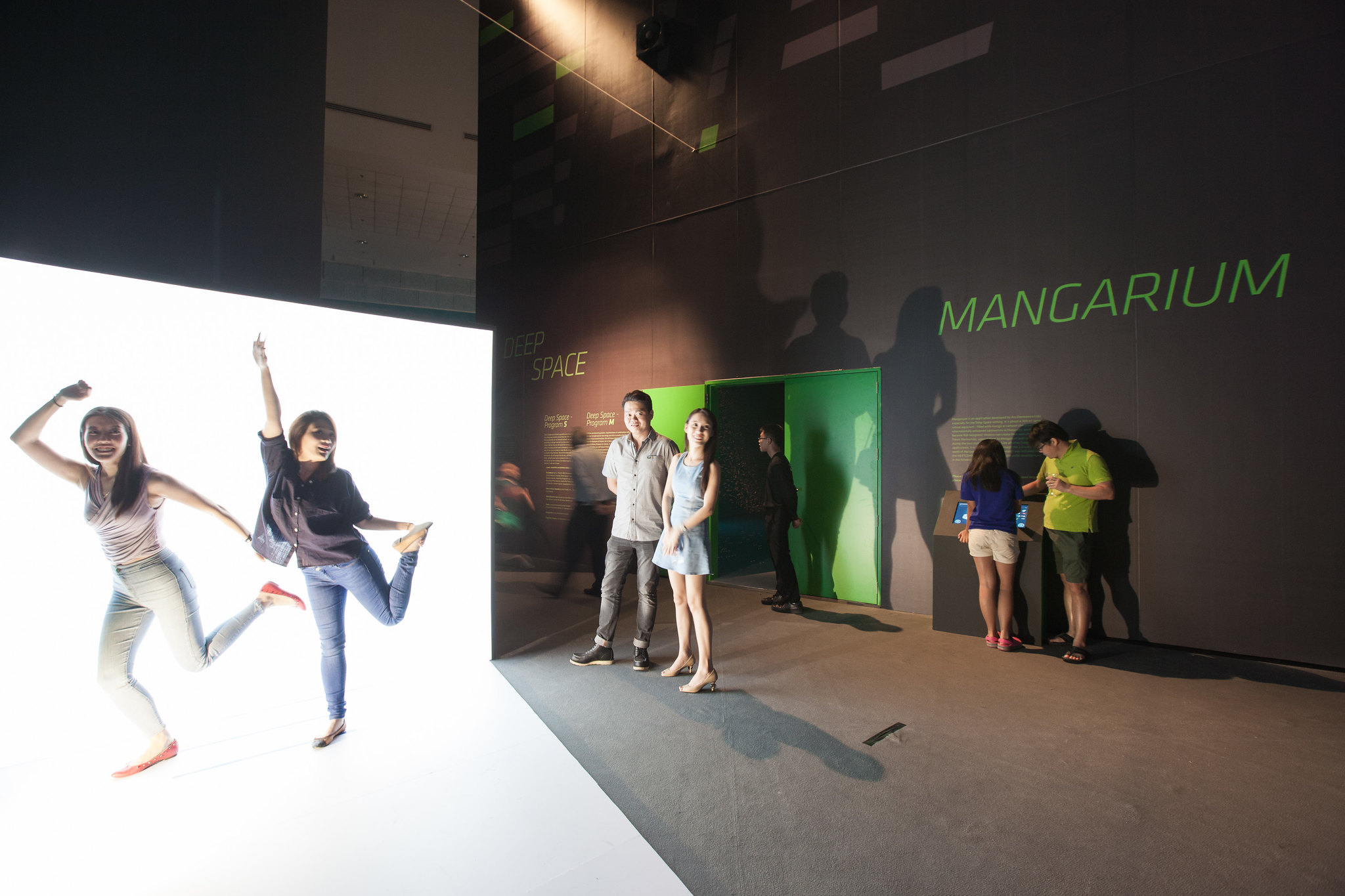
Shadowgram is like a social sculpture that thrives and grows as long as the installation visitors contribute their shadow and their opinion on a particular topic. The core artistic intention was to create what can be called a ‘creative catalyst’, a system that enables the audience to discover, play with, and use their creativity. The participants pose expressively as if they were on stage and are photographed as they do. The illuminated background provides the perfect lighting for a shadow shot and also attracts public attention to the audience members’ gestures in response to the topic. The shadow portraits are then printed to adhesive foil and excised. These images and the inscribable adhesive speech balloons that can be applied next to them enable installation visitors to leave behind communiqués in the exhibition space.
Ars Electronica Futurelab (Gerfried Stocker, Horst Hörtner, Christopher Lindinger, Daniela Kuka, Michael Badics, Oliver Elias, Wolfgang Hauer, Andreas Jalsovec, Florian Krebs, Ronald Martins, Benjamin Mayr, Michael Mayr, Otto Naderer, Andreas Pramböck, Christian Reisenberger), 2009
Deep Space (mobile version)

Deep Space is a multidimensional space, originally with a total of eight 1080p HD and Active Stereo-capable Barco Galaxy NH12 projectors that let you enjoy the micro- and macrocosm in crystal-clear, 16×9-meter images displayed on the Deep Space’s wall and floor at the Ars Electronica Center in Linz, Austria. For the Science Centre Singapore, a smaller version of Deep Space (mobile version) has been developed and offers you the opportunity to travel to far-away or long-vanished places and to see things you’ve never feasted your eyes on before! You can blast off on a journey through the entire known universe, or populate a cartoon ocean with sea creatures you design yourself. Artworks of incredible beauty will enchant you and you’ll marvel at impressive images from diverse domains of science and art.
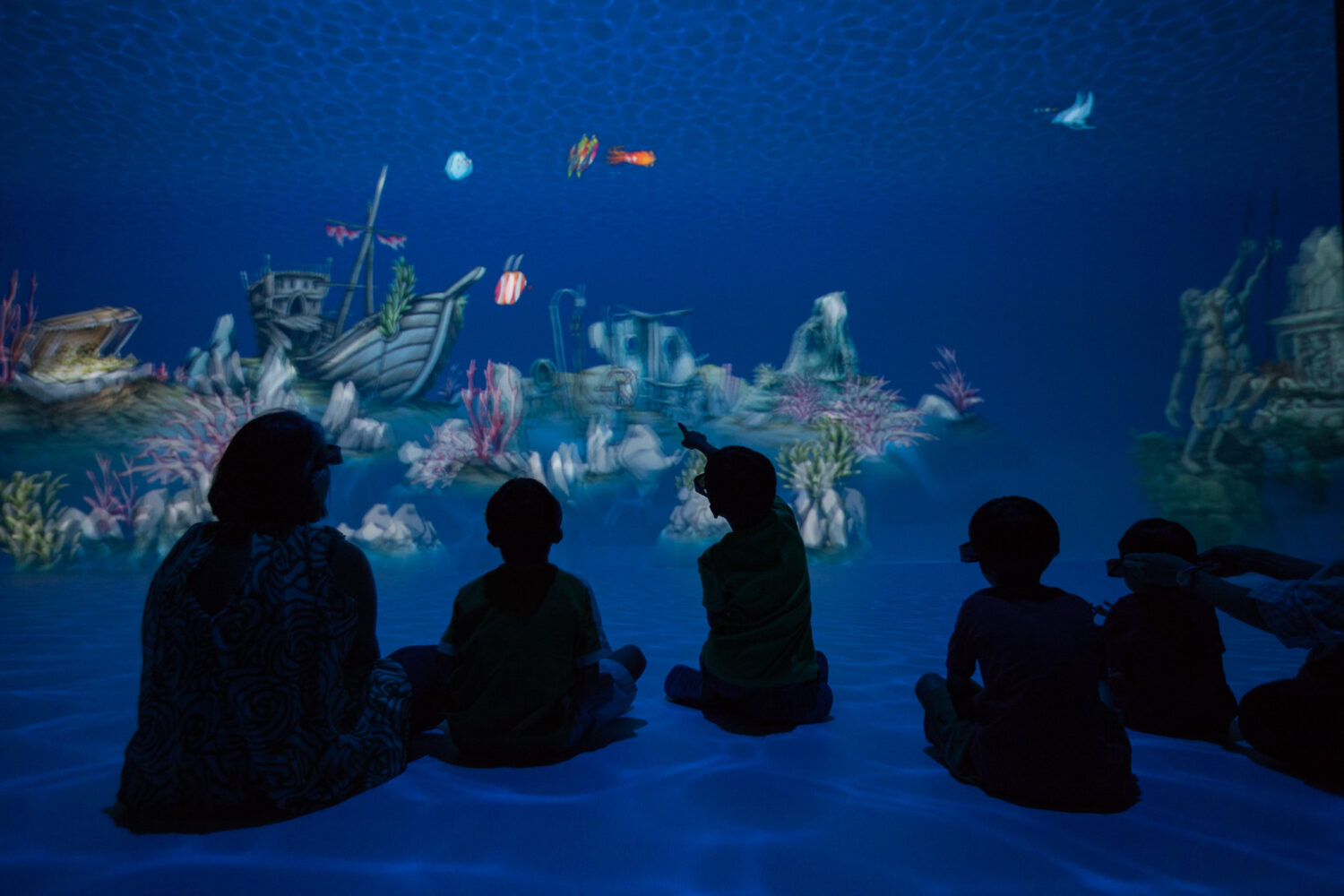
Deep Space – Program S
Small children are invited to go with us on a tour that offers insights into things we normally cannot do or see. We will run on carpets that we normally are not allowed to touch; we will try catching butterflies or get involved in a story about a crane that returns a favor. We will fearlessly search for bear in Yosemite Valley in California and watch animations to understand why the sun lost a beam of light and why the life of a small pig is so difficult in a world of big creatures. We end the show with interactive 3-D animations: we will plunge into the sea, follow our self-drawn fish and come back to the surface in order to help an island that was set on fire by doing a rain dance together with indigenous creatures made out of paper.
- Carpets, butterflies and skeleton videos by Lois Lammerhuber
- StoryWeaver by h.o; Pianist: Maki Namekawa; Composition: Chiaki Ishikawa; Drawing: Emiko Ogawa; Visual Programming: Naohiro Hayaishi; Workshop Programming: Tetsuro Yasunaga; Recording: Philip Huemer; Audio Post Production: Istvan Szabo; Art Direction: Hideaki Ogawa; Supported by: Arts Council Tokyo
- xRez in Focus: Yosemite by xRez Studio, Inc. – Eric Hanson, Greg Dowing
- Giant Episode 2: Sun directed by Celine Desrumaux & Yann Benedi; Sounds David Kamp; Severin Labit
- Ormie created and directed by Rob Silvestri; Produced by Graham Moloy; CG Supervisor: Ken Ouellette;
- Mangarium by Ars Electronica Futurelab
- Papyrate’s Island by Ars Electronica Futurelab
Deep Space – Program M
Children are driven by passion, inquisitiveness in combination with courage to reach out for new things, and this is exactly what Deep Space tries to accommodate. We will have a detailed look at carpets from the Museum of Islamic Art in Doha and at collections from the Natural History Museum in Vienna. In 3-D we will plunge into the sea, follow our self-drawn fish and come back to surface to visit an island created by artists from the Ars Electronica Futurelab. However, we will use the island as a trampoline to free us from gravity. Then we can go flying into the universe and discover the ambiguity of space and time via an interactive tour of the entire observable universe. We will end the tour by beaming ourselves back to Earth and find ourselves skiing at more than 140km/h down the world-renowned Hahnenkamm slope in the Austrian Alps.
- Carpets, butterflies and skeleton videos by Lois Lammerhuber
- Mangarium by Ars Electronica Futurelab
- Papyrate’s Island by Ars Electronica Futurelab
- Uniview – Scaling the Universe by SCISS AB
- Hahnenkamm 3D recorded by Red Bull Media House; 3-D stereo production by Dank Quantels Pablo (quantel.com)
- Ormie created and directed by Rob Silvestri; Produced by Graham Moloy; CG Supervisor: Ken Ouellette
Deep Space – Program L
How can we try to see things differently in order to open up new perspectives and insights? This is exactly one of the challenges Deep Space tries to focus on. We go on space explorations as well as deep into the details of the microcosm. We try to understand why Leonardo Da Vinci was the first genius in drawing perspectives and we will lose orientation in artistic applications. We will have an outstanding look at Paris and will elaborate on the actual discrepancy of skies and perspectives. After overcoming the horizon, we will find ourselves flying off into the universe to discover the ambiguity of space and time via an interactive tour of the entire observable universe. We return to Earth to go skiing down the world-renowned Hahnenkamm slope. With irritated senses, we will end the tour by considering the topic of change of perception.
- Space Exploration by Ars Electronica Futurelab
- NOHlab Video by NOHlab; Music: Maki Namekawa; Technical supervising: Bager Akbay; (Live) Visuals & Programming: Plato Media Lab ( Bager Akbay, Osman Koc, Zeynep Nal, Kaan Kaner, Ismail Kasarci);
- Mona Lisa – Leonardo Da Vinci by Lois Lammerhuber
- From Austria to the World: Paris by Lois Lammerhuber/Martin Ackerl
- Spaxels Showreel by Ars Electronica Futurelab
- Uniview – Scaling the Universe by SCISS AB
- Hahnenkamm 3D recorded by Red Bull Media House; 3-D stereo production by Dank Quantels Pablo (quantel.com)
- Box directed by BOT & DOLLY
- Walking City by Universal Everything; Creative Director: Matt Pyke; Animation: Chris Perry; Sound: Simon Pyke
Mangarium
Mangarium is an application developed by Ars Electronica Linz especially for the Deep Space setting. It’s an approximately 300 m2 large virtual aquarium – filled with manga or cartoon characters by internationally renowned cartoonists or those who want to become fish designers! Visitors can create their own imaginative fish themselves, upload them to Mangarium and watch them during their next visit in Deep Space. Like all other Deep Space applications, it is possible to move through the 3-D underwater world of Mangarium via an iPod. The project was initiated for the NEXTCOMIC Festival 2011 and was still under development during the following years.